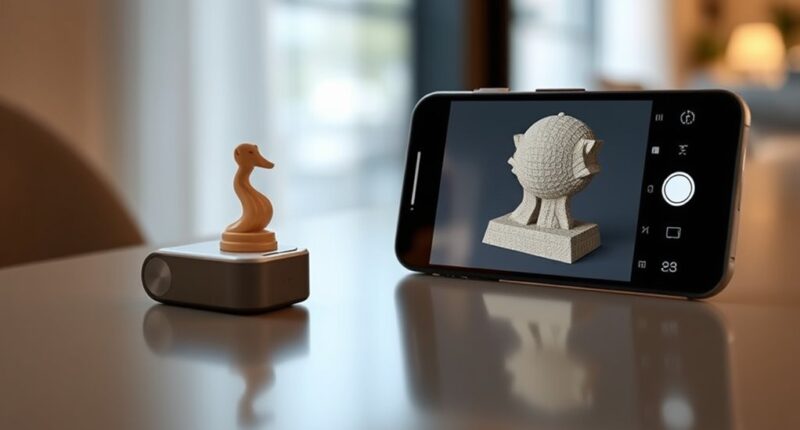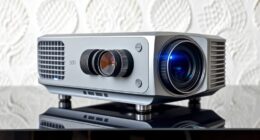If you’re looking for the best 3D scanners for phones in 2025, I recommend the Creality CR-Scan Ferret Pro, Otter Lite, and similar portable, high-precision options. These devices are lightweight, support wireless connectivity, and deliver amazing detail with accuracy up to 0.1mm, perfect for hobbyists and professionals alike. They work well outdoors and can scan even shiny or dark surfaces. Keep exploring to discover which tool suits your needs best and how to get the most out of it.
Key Takeaways
- Portable, lightweight 3D scanners like Creality CR-Scan Ferret Pro support wireless connectivity and high-precision capture for phone compatibility.
- Compatibility spans Android, iOS, Windows, and macOS, ensuring seamless integration with various smartphones and tablets.
- Advanced features such as full-color texture capture, fast scanning speeds, and multi-format support enhance detail and usability.
- Environmental resilience allows outdoor scanning in bright light and on reflective surfaces without additional powders.
- User-friendly interfaces, automatic stabilization, and tutorials make high-quality 3D scanning accessible for both professionals and hobbyists.
Creality 3D Scanner CR-Scan Ferret Pro for 3D Printing
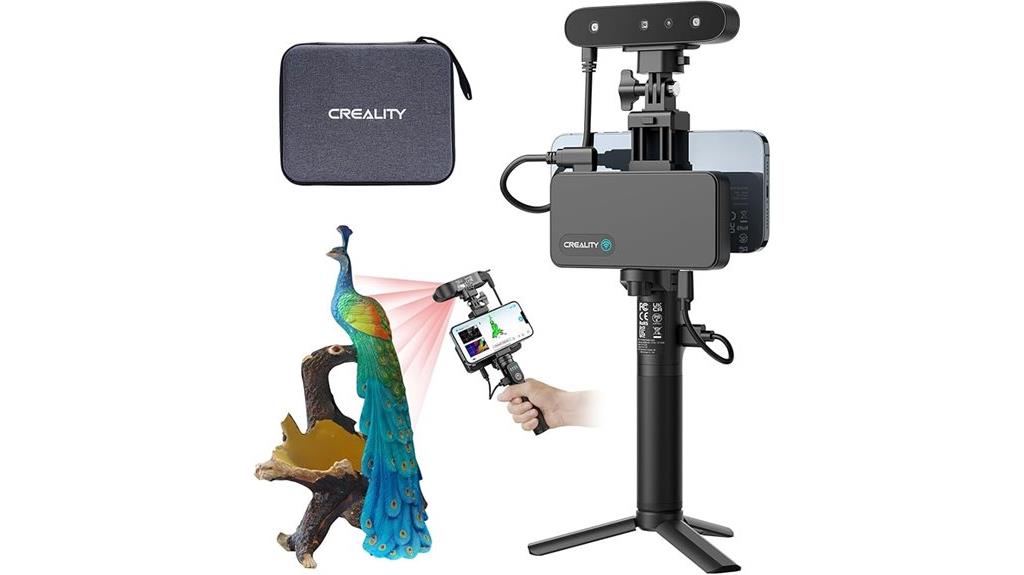
If you’re looking for a portable, high-precision 3D scanner that’s easy to use for detailed modeling, the Creality 3D Scanner CR-Scan Ferret Pro is an excellent choice. Weighing just 105 grams, it supports wireless connectivity via WiFi6, making scans smooth and reliable even in less-than-ideal conditions. With 0.1mm accuracy, anti-shake technology, and full-color 24-bit data capture, it produces high-quality results suitable for intricate projects. The scanner supports multiple formats like OBJ, STL, and PLY, and performs well under various lighting conditions, including sunlight. Its user-friendly design makes on-the-go scanning simple and efficient.
Best For: hobbyists, digital artists, and professionals seeking portable, high-precision 3D scanning for detailed modeling and creative projects.
Pros:
- Lightweight and portable at only 105 grams, ideal for on-the-go scanning
- Supports multiple file formats (OBJ, STL, PLY) for versatile use
- High accuracy of 0.1mm with full-color 24-bit data capture for detailed results
Cons:
- Performance depends on system hardware; may require specific configurations for optimal use
- Slightly lower overall user rating (3.6/5 stars) based on reviews, indicating some user concerns
- First availability is scheduled for November 30, 2023, which may delay access for some users
Creality CR-Scan Ferret Pro 3D Scanner
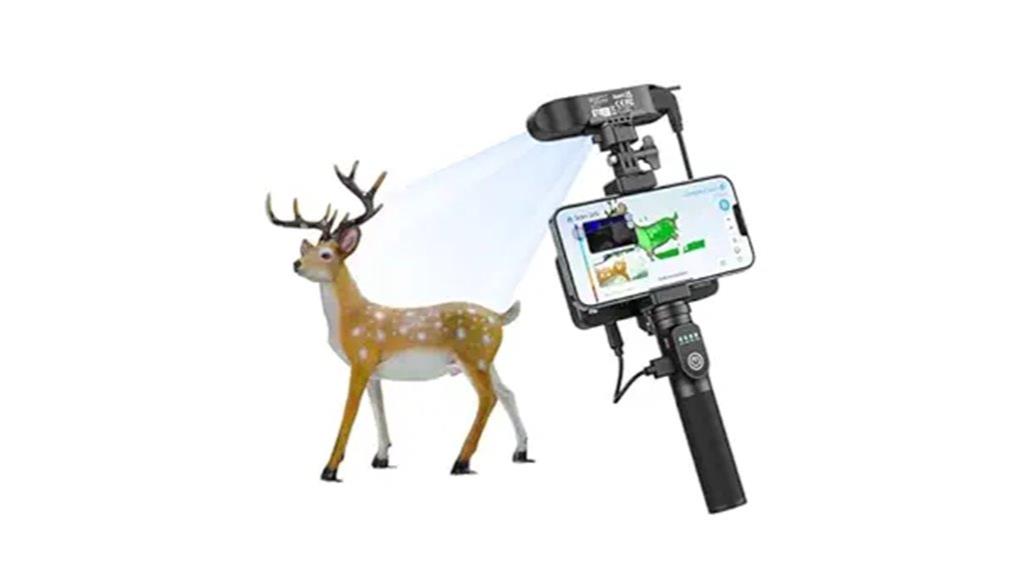
The Creality CR-Scan Ferret Pro stands out for its high-precision scanning capabilities, making it ideal for professionals and serious hobbyists who demand detailed and accurate 3D models. It offers up to 0.1mm accuracy, capturing intricate textures and colors with full-color 3D imaging at 24-bit resolution. Its built-in ASIC chip enables fast scans of medium-large objects like cars or tires, even without spray. The scanner’s anti-shake One-Shot technology guarantees steady, smooth operation, while WiFi6 provides rapid wireless data transfer. Compatible with various devices and supporting multiple formats, it’s a versatile tool for detailed 3D capture in diverse environments.
Best For: professionals and serious hobbyists seeking high-precision, full-color 3D scanning for detailed models of medium-large objects in various environments.
Pros:
- Up to 0.1mm high accuracy ensures precise and detailed 3D captures.
- Fast scanning with built-in ASIC chip and WiFi6 wireless transfer enhances efficiency.
- Supports multiple output formats and device compatibility for seamless workflow integration.
Cons:
- May require a powerful system (Windows or Mac with recent specs) for optimal performance.
- Slightly higher cost compared to entry-level scanners may be a consideration for hobbyists.
- The need for accessories like WiFi box and power bank could add to setup complexity.
Creality 3D Scanner CR-Scan Ferret for 3D Printing
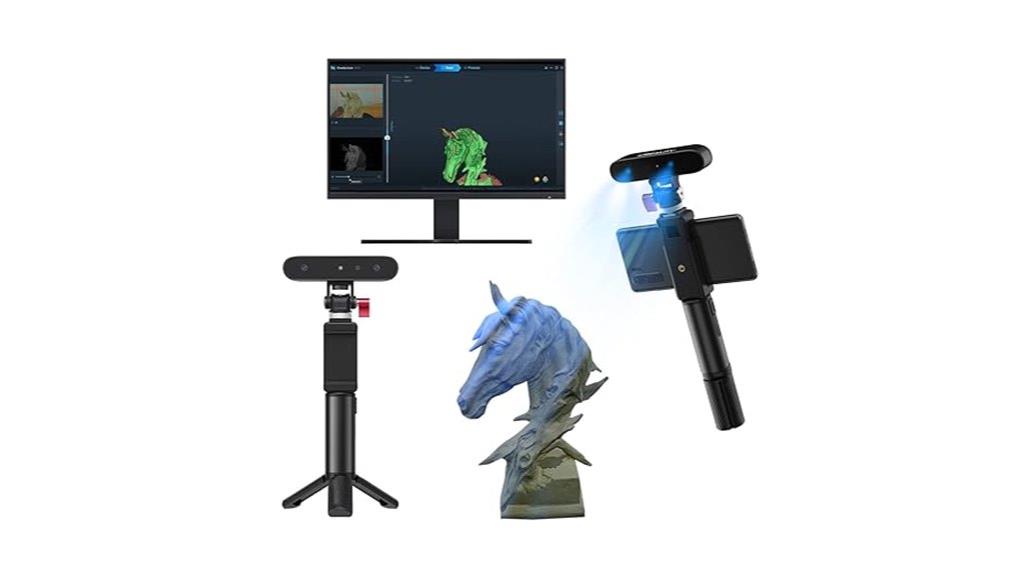
For those seeking high-precision, full-color 3D scanning on a portable device, the Creality 3D Scanner CR-Scan Ferret stands out as an excellent choice. It’s compatible with Android phones, Windows, macOS, and iOS devices, making it versatile for various users. With dual-mode scanning—wide-range and high-accuracy—it captures objects up to 560*820mm or provides 0.1mm precision for detailed models. Its powerful ASIC chips process images rapidly, ensuring smooth, efficient scans at over 60 fps. The built-in color camera delivers realistic textures, while flexible power options, like power banks, support on-the-go use. Firmware updates further enhance its capabilities for detailed 3D printing projects.
Best For: hobbyists, 3D printing enthusiasts, and professionals needing portable, high-precision, full-color 3D scanning solutions.
Pros:
- Supports multiple platforms including Android, iOS, Windows, and macOS for versatile compatibility
- Dual-mode scanning (wide-range and high-accuracy) for detailed and large object capture
- Rapid image processing with ASIC chips ensures smooth, efficient scans at over 60 fps
Cons:
- Requires verification of device compatibility prior to purchase to ensure optimal performance
- High system requirements (e.g., Windows i5-Gen8 or higher, >8GB RAM) may limit use on older computers
- Limited to objects within specified size range; larger objects may not be suitable for scanning
Creality CR Scan Ferret Pro 3D Scanner for 3D Printing
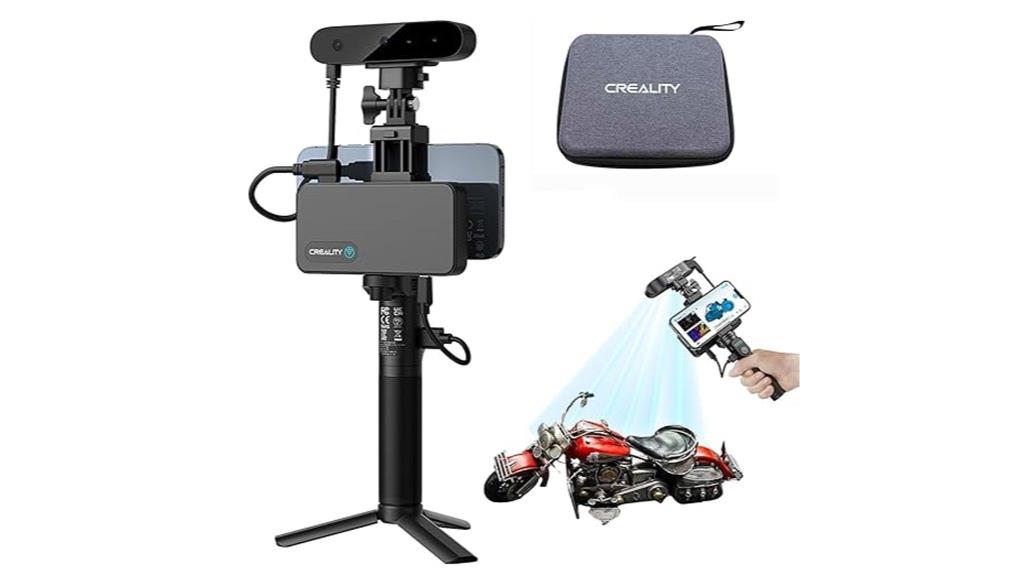
The Creality CR Scan Ferret Pro stands out for its combination of portability and professional accuracy, making it an ideal choice for users who need a reliable handheld 3D scanner on the go. Weighing just 105g, it’s lightweight and easy to handle, supporting wireless connection via WiFi 6 or USB (except on iPhone). Its high accuracy of up to 0.1mm captures detailed, full-color 3D models with realistic textures, thanks to a built-in 2MP RGB camera. The Ferret Pro performs well outdoors and on challenging surfaces like black or metallic objects, making it versatile for art, design, and prototyping. It’s user-friendly, with quick setup and stabilization features for smooth scans everywhere.
Best For: hobbyists, artists, and professionals seeking a portable, high-precision 3D scanner for detailed models in various environments.
Pros:
- Lightweight and portable at only 105g for easy handheld use on the go
- High accuracy of up to 0.1mm with full-color, textured 3D models
- Compatible with multiple devices and supports wireless connection via WiFi 6 or USB (excluding iPhone)
Cons:
- USB connection not supported on iPhone, limiting some mobile options
- May require some learning curve for beginners despite user-friendly guides
- Performance may vary in extremely bright outdoor lighting despite stabilization features
Creality CR Scan Ferret Pro 3D Scanner
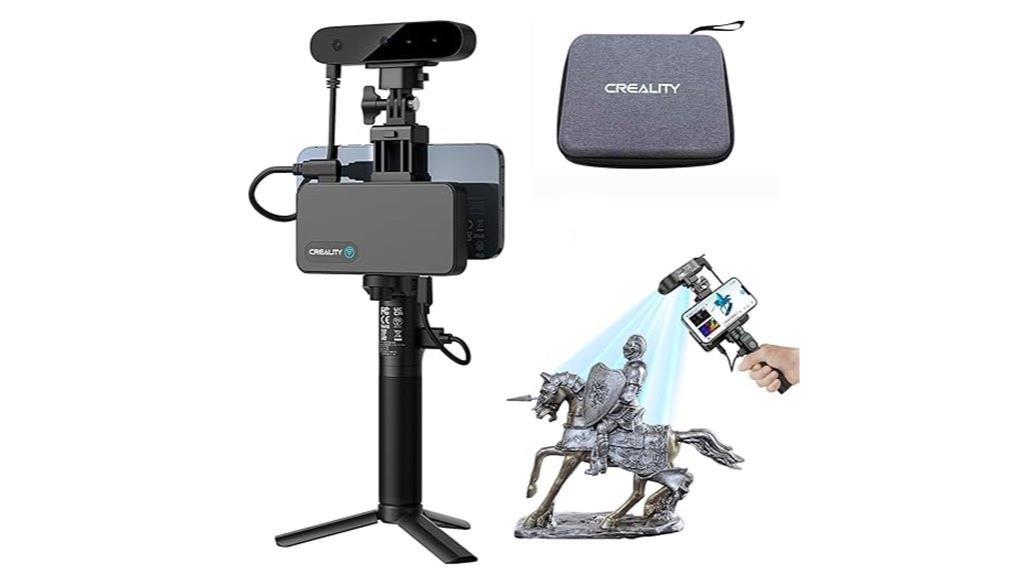
If you’re looking for a portable 3D scanner that delivers professional-grade results, the Creality CR Scan Ferret Pro is an excellent choice. It offers high-precision scanning with up to 0.1mm accuracy and captures full-color details using a 24-bit color camera. Its anti-shake technology guarantees smooth scans, even on difficult surfaces like black or metallic objects, without spraying. Weighing just 105 grams, it’s perfect for outdoor use in bright sunlight and easy to carry anywhere. With wireless connectivity via WiFi 6 and compatibility across multiple devices, this scanner makes detailed, realistic 3D modeling accessible anytime, anywhere.
Best For: professionals and hobbyists seeking portable, high-precision 3D scanning for creative, engineering, or outdoor applications.
Pros:
- Achieves up to 0.1mm accuracy with full-color 24-bit detail.
- Anti-shake technology ensures smooth scans on challenging surfaces.
- Lightweight and portable design suitable for outdoor use in bright sunlight.
Cons:
- May require familiarity with setup and calibration processes.
- Limited to compatible devices supporting WiFi 6 and specific OS options.
- The compact size might restrict scanning larger objects or extensive areas.
Creality CR-Ferret SE 3D Scanner for 3D Printing
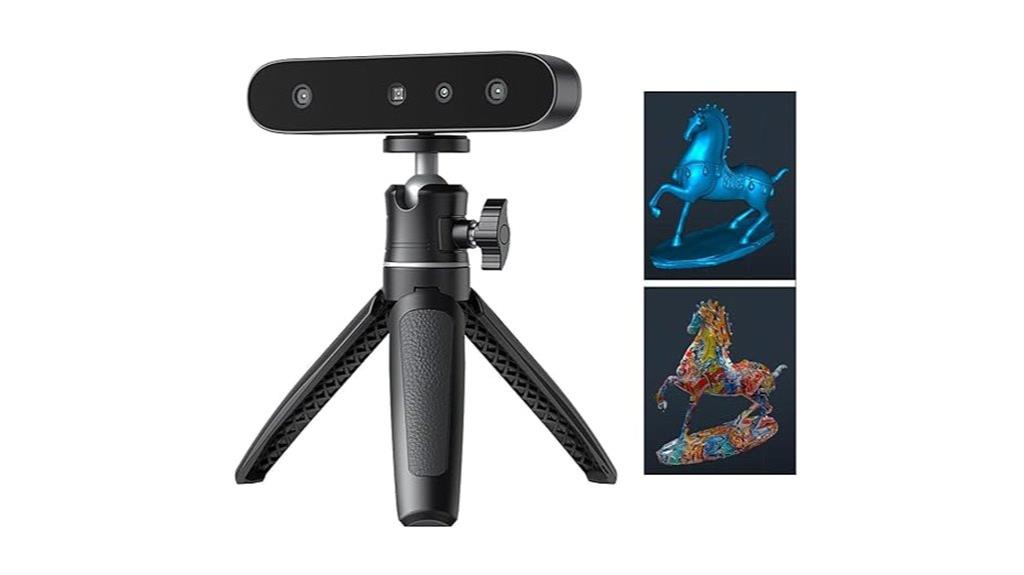
When searching for a 3D scanner that balances precision and ease of use, the Creality CR-Ferret SE stands out with its impressive accuracy of up to 0.1mm and fast 30FPS scanning speed. It captures detailed, realistic models quickly and smoothly, thanks to advanced one-shot 3D imaging that works well even with shaky hands or rapid movements. Its built-in 2MP color camera reproduces intricate textures and colors, creating full-color, lifelike models. With a large scanning range of up to 2000mm and a single capture area of 560x820mm, it handles medium to large objects efficiently, making it ideal for 3D printing projects of various sizes.
Best For: hobbyists and professionals seeking high-precision, full-color 3D scans of medium to large objects for 3D printing projects.
Pros:
- High accuracy of up to 0.1mm and fast 30FPS scanning speed for detailed models
- Capable of capturing full-color textures with its built-in 2MP camera, creating realistic 3D representations
- Large scanning range up to 2000mm and single capture area of 560x820mm for medium to large objects
Cons:
- May be relatively expensive for casual users or beginners on a budget
- Requires adequate lighting conditions for optimal color and texture capture
- Handling very small or highly intricate objects might be less effective due to resolution limits
Creality CR-Scan Ferret Pro 3D Scanner
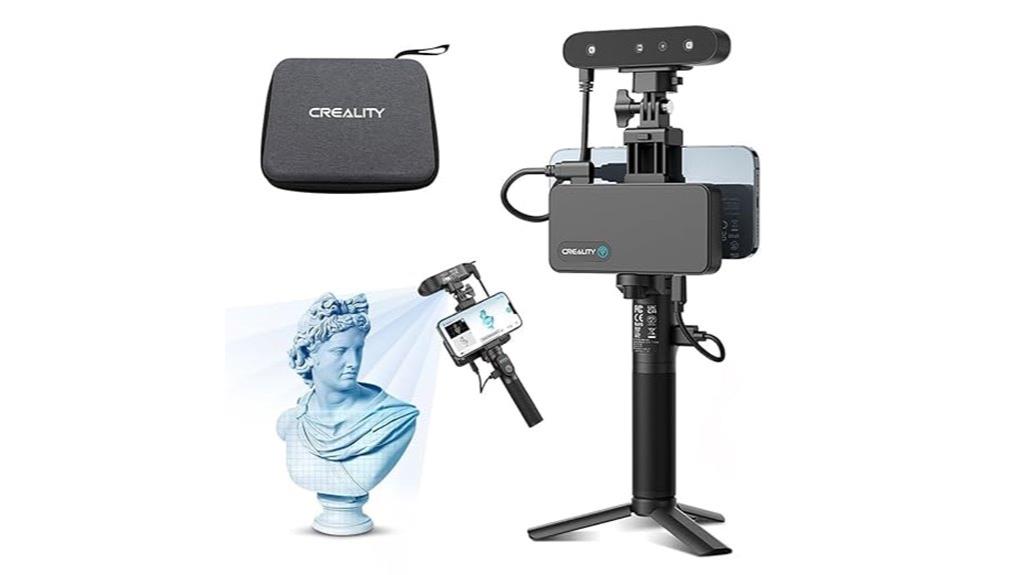
With its ultra-fast WiFi 6 connectivity, the Creality CR-Scan Ferret Pro delivers blazing data transfer speeds that make high-precision scanning quick and effortless. It supports wireless connections via WiFi 6 or USB to Windows, Mac, and Android devices, while iPhone users can connect wirelessly only. The scanner captures vibrant, full-color 3D models with 0.1mm accuracy and 0.16mm resolution, even on tricky surfaces like black or metal, without needing sprays. Its anti-shake tracking guarantees stable results during both stationary and moving scans. The complete package, including a tripod, phone holder, and tutorials, makes setup easy, backed by a 180-day warranty for added confidence.
Best For: Professionals and enthusiasts seeking fast, high-precision color 3D scanning with versatile device compatibility and minimal setup.
Pros:
- Ultra-fast data transfer with WiFi 6 ensures efficient, high-quality scans.
- Supports vibrant, full-color 3D models with impressive detail and accuracy.
- Complete package with accessories and tutorials simplifies setup and operation.
Cons:
- iPhone users can only connect via WiFi, no USB support.
- Requires a stable WiFi 6 network for optimal performance, which may not be available everywhere.
- Lacks built-in spray-free scanning capability, limiting use on certain reflective surfaces.
iOS Connect for Mole 3D Scanner
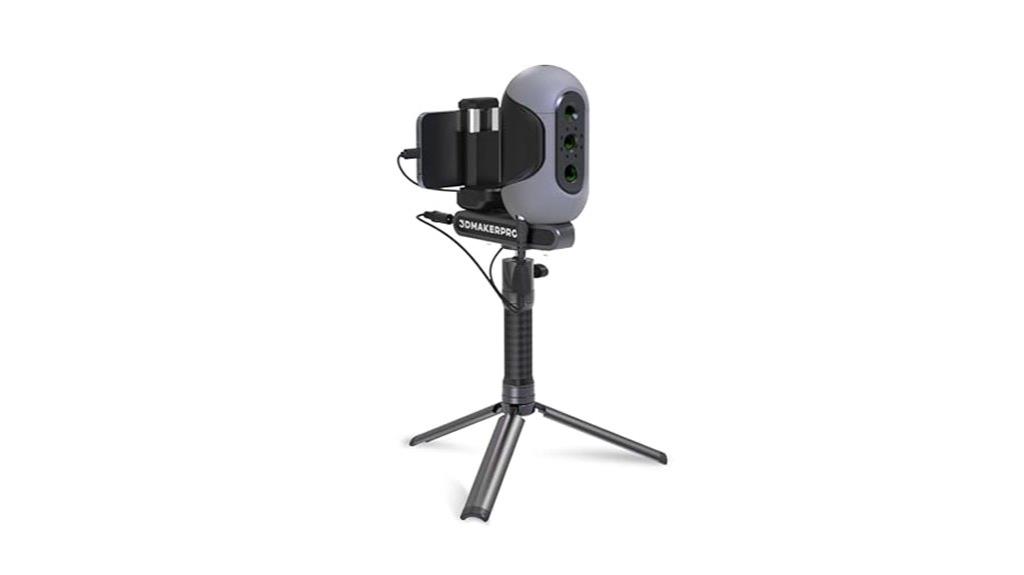
The iOS Connect for Mole 3D Scanner stands out for users who need a portable, reliable solution for scanning large or complex objects directly with their iPhone. Its compact design and easy setup let you scan anywhere—whether in a studio or out in the field. The kit includes the Connect device, phone clip, scanner cable, and phone cable, but requires a compatible power bank, ideally a 12V PD 22.5W Type-C. It works seamlessly with iPhones running iOS 15.0+ (preferably iPhone 12 or newer). This setup enables detailed, large-object scans, making it perfect for professionals and hobbyists alike.
Best For: professionals and hobbyists who need a portable, high-quality solution for scanning large or complex objects with their iPhone in various environments.
Pros:
- Compact, portable design allows for easy use in the studio or field.
- Compatible with iPhones running iOS 15.0+ and capable of detailed large-object scans.
- Includes all necessary accessories (phone clip, cables) with a recommended power bank for reliable operation.
Cons:
- Does not include a power bank; users must purchase a compatible 12V PD 22.5W Type-C power source separately.
- Compatibility may vary with certain phone models, especially older or non-official OTG-supported devices.
- Requires specific system requirements (iOS 15.0+), limiting use with older phones or other operating systems.
Creality 3D Scanner CR-Scan Ferret for 3D Printing

If you’re looking for a versatile 3D scanner that combines high precision with portability, the Creality 3D Scanner CR-Scan Ferret stands out. It features dual-mode scanning, perfect for creating detailed 3D models or supporting 3D printing. Compatible with Android phones, Windows 10/11 PCs, and powered by flexible charging options like power banks, it’s great for on-the-go use. With a high-precision mode achieving 0.1mm accuracy and capturing true color textures, it produces realistic, detailed models quickly. Its advanced ASIC chip processes images at 60 fps, ensuring fast, smooth scans. Overall, the Ferret offers excellent value for hobbyists and professionals alike.
Best For: hobbyists and professionals seeking a portable, high-precision 3D scanner for creating detailed, true-color 3D models on the go.
Pros:
- Dual-mode scanning offers flexibility for different modeling needs.
- High precision of 0.1mm ensures detailed and accurate 3D captures.
- Compatible with various devices and powered by a fast, advanced ASIC chip for quick, smooth scans.
Cons:
- Limited maximum scan size of 560*820mm may restrict larger object scanning.
- Requires compatible Android or Windows devices, which may limit use with other platforms.
- Slight learning curve for beginners unfamiliar with 3D scanning technology.
Creality 3D Scanner CR-Scan Ferret Pro for 3D Printing
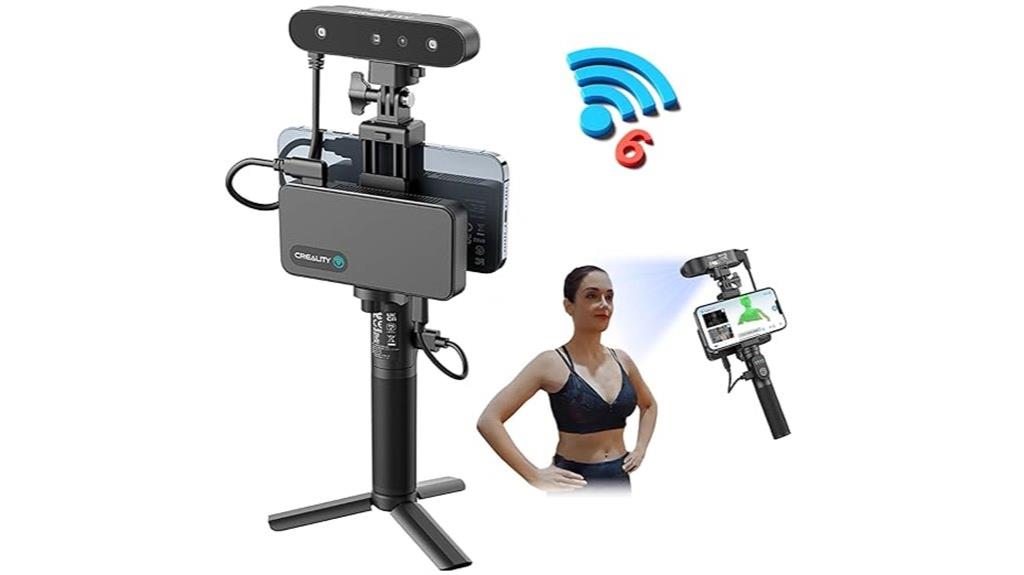
If you’re looking for a handheld 3D scanner that combines high precision with user-friendly operation, the Creality CR-Scan Ferret Pro stands out as an excellent choice for 3D printing enthusiasts. It features advanced one-shot 3D imaging, anti-shake tracking, and 0.1mm accuracy, making high-quality scans effortless. Compatible with Android, iOS, PC, and Mac, it offers versatile use across devices. Its WiFi6 connection ensures fast, real-time data transfer, even for large models. Designed for quick setup and simple to use, the Ferret Pro adapts seamlessly to outdoor and indoor environments, delivering precise, print-ready models with minimal effort.
Best For: 3D printing enthusiasts and professionals seeking high-precision, easy-to-use handheld 3D scanning for both indoor and outdoor applications.
Pros:
- Offers high accuracy of 0.1mm, ensuring detailed, print-ready models.
- Compatible with multiple platforms including Android, iOS, PC, and Mac for versatile use.
- Features WiFi6 connectivity for fast, real-time data transfer even with large models.
Cons:
- May be more expensive compared to basic 3D scanners.
- Requires some learning curve despite its user-friendly design.
- Performance outdoors depends on lighting conditions, which may affect scans in very bright sunlight.
Creality Scan Bridge for 3D Scanner Otter
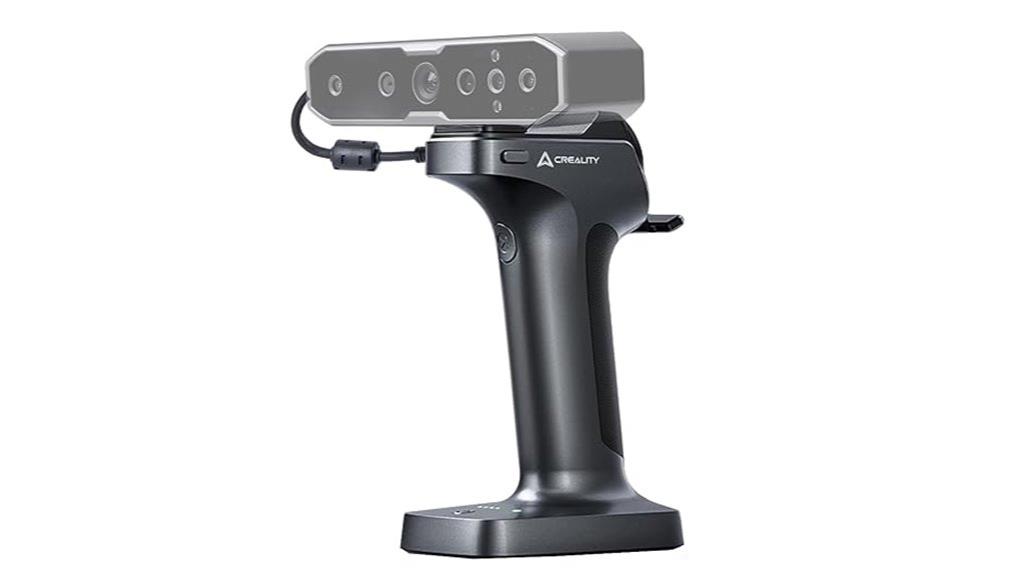
Creality Scan Bridge stands out for users who want seamless wireless connectivity with their Creality CR-Scan Otter, making it ideal for those seeking efficient, cable-free 3D scanning. It supports high-speed WiFi 6 transmission, guaranteeing reliable data transfer at 50fps in laser line mode and 30fps in infrared mode. The device features a large battery lasting over three hours, fast charging, and easy installation with a magnetic suction cup. Its intuitive controls and status indicators make operation straightforward, whether scanning directly via a phone app or connecting to a PC. Overall, it simplifies workflows, enhances flexibility, and assures a smooth, cable-free scanning experience.
Best For: users seeking a reliable, wireless 3D scanning solution with high-speed data transfer and easy setup for the Creality CR-Scan Otter.
Pros:
- Supports high-speed WiFi 6 transmission for smooth, cable-free scanning at 50fps in laser line mode and 30fps in infrared mode.
- Long-lasting large-capacity battery with over three hours of continuous use and fast charging capabilities.
- Easy installation and operation with magnetic suction, intuitive controls, and clear status indicators.
Cons:
- May require firmware updates or troubleshooting for certain connection or recognition issues on Windows or Mac systems.
- Limited compatibility strictly to Creality CR-Scan Otter and Otter series scanners.
- Dependence on WiFi stability could affect performance in environments with poor network conditions.
Creality 3D Scanner CR-Scan Ferret Pro for 3D Printing
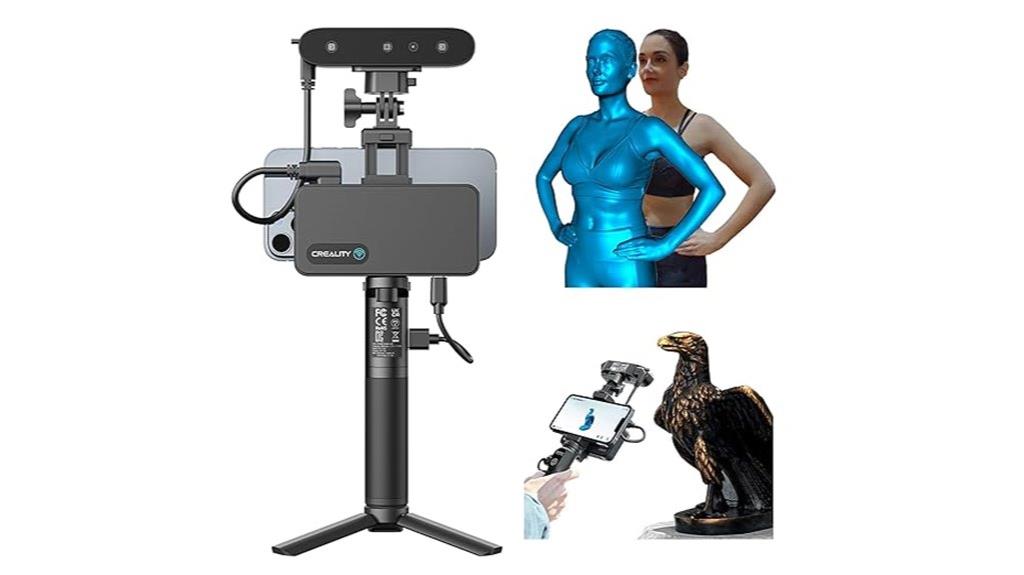
The Creality CR-Scan Ferret Pro stands out as an ideal choice for professionals and serious hobbyists seeking high-precision 3D scans for printing and modeling. Its 0.1mm accuracy guarantees detailed, reliable results, even for complex projects. The device’s full-color scanning captures realistic textures, while advanced anti-shake tech keeps scans steady. Wireless connectivity via WiFi6 makes it easy to use on the go, supporting multiple formats like OBJ, STL, and PLY for seamless software integration. Weighing just 105 grams, it’s lightweight and portable, perfect for quick, high-quality 3D captures anytime, anywhere.
Best For: professionals and serious hobbyists seeking high-precision, full-color 3D scans for printing, modeling, and detailed design projects.
Pros:
- High accuracy of 0.1mm ensures detailed and reliable scans for complex projects
- Full-color scanning captures realistic textures and details
- Wireless connectivity via WiFi6 offers convenience and portability for on-the-go use
Cons:
- May be more expensive than entry-level 3D scanners suitable for beginners
- Requires compatible software like Maya, 3DMax, or Fusion 360 for optimal use
- Slight learning curve for users new to 3D scanning technology
Creality 3D Scanner Otter Lite, Handheld Wireless Scanner
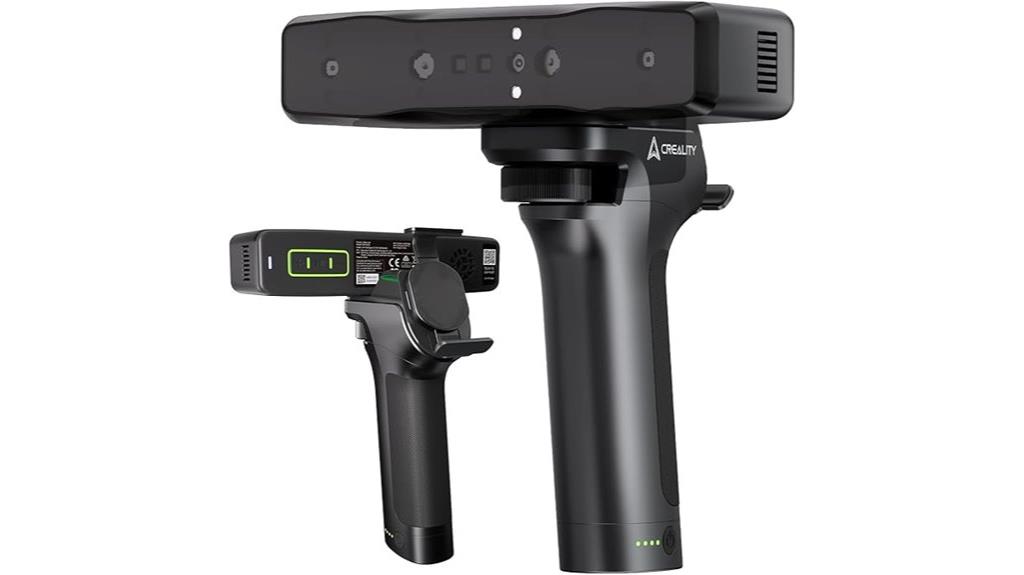
Designed for users who need a versatile and portable 3D scanning solution, the Creality Otter Lite stands out with its wireless handheld design that supports multiple platforms, including Windows, Mac, iPhone, and Android. It offers an impressive accuracy of 0.05mm, thanks to anti-shake tracking and up to 30FPS scanning speed. Its seamless wireless data transmission and real-time mirroring make scanning on the go effortless. Capable of capturing objects from tiny 5mm parts to large 4-meter objects, it’s perfect for everything from small components to cars. Its advanced laser and imaging tech, combined with user-friendly software, makes detailed, professional scans accessible to everyone.
Best For: professionals and hobbyists who require a portable, high-precision 3D scanner capable of capturing small to large objects across multiple platforms with ease.
Pros:
- Supports multiple platforms including Windows, Mac, iPhone, and Android, ensuring wide compatibility.
- High accuracy of 0.05mm with anti-shake tracking and fast 30FPS scanning speed for detailed results.
- Wireless design with real-time mirroring and seamless data transmission enhances mobility and ease of use.
Cons:
- The advanced features and software may require a learning curve for beginners.
- Large object scanning up to 4 meters may be limited by the physical size of the object or scanning environment.
- Battery life and wireless stability can vary based on usage and device compatibility.
Creality 3D Scanner CR-Scan Ferret Pro for 3D Printing
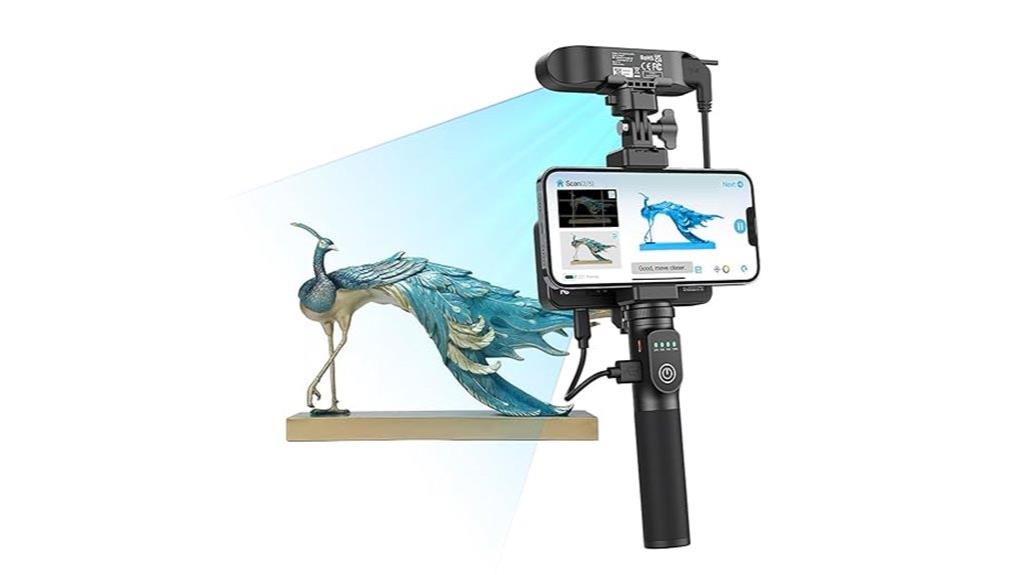
If you’re looking for a versatile 3D scanner that delivers fast, accurate results suitable for professional 3D printing, the CR-Scan Ferret Pro stands out. It supports dual connectivity: WiFi on mobile devices and data cables on PCs, compatible with Windows, macOS, Android, and iPhones. With 0.1mm accuracy, a built-in ASIC chip, and WiFi6, it scans medium-large objects quickly at up to 20 fps. Its full-color RGB camera and lighting enhance detail and realism, even in low-light conditions. Advanced stabilization and autofocus guarantee smooth, precise scans, making it ideal for capturing complex textures, metallic surfaces, and detailed models effortlessly.
Best For: professionals and enthusiasts seeking fast, precise, and versatile 3D scanning for detailed models, industrial parts, or complex textures across various environments and surfaces.
Pros:
- Supports dual connectivity with WiFi and data cable for flexible use across devices.
- High accuracy of 0.1mm and fast scanning speed up to 20 fps for detailed, efficient captures.
- Full-color RGB imaging with advanced lighting and stabilization for realistic, high-quality textures even in challenging lighting conditions.
Cons:
- Requires compatible hardware with specific specifications on Windows, macOS, Android, or iPhone, which may limit some users.
- Slightly higher cost due to advanced features and high precision technology.
- May have a learning curve for optimal use of advanced imaging and stabilization features.
Seal Lite Handheld 3D Scanner for 3D Printers
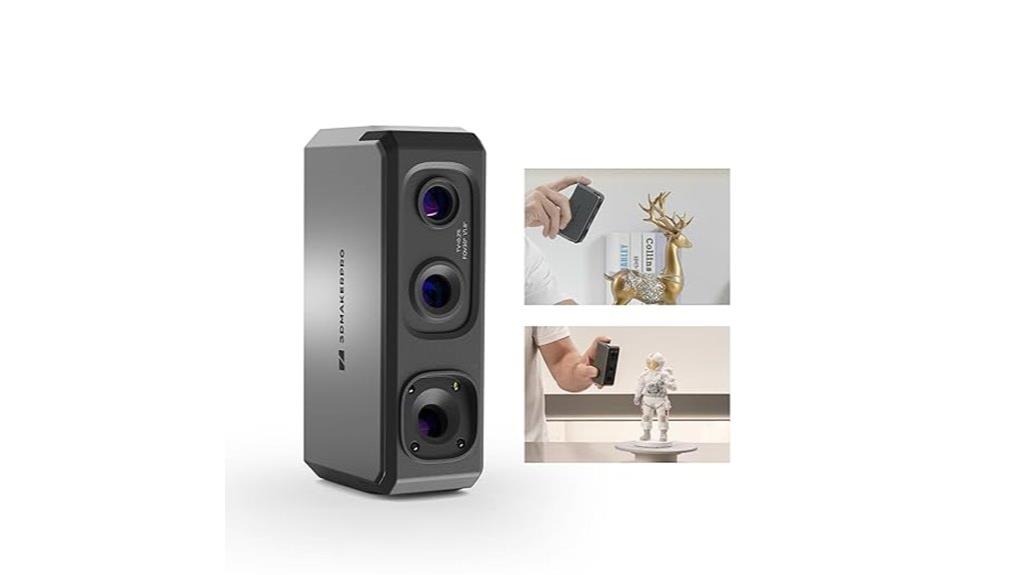
For hobbyists and small-scale creators seeking precise 3D scans, the Seal Lite Handheld 3D Scanner stands out thanks to its high accuracy of 0.02mm and fast scanning rate of 100,000 points per second. Weighing only 225g, it’s portable and easy to handle, with features like 9-level light adjustment, anti-shake lenses, and optical stabilization to improve scan quality. It excels at capturing small objects and fine details but struggles with dark or shiny surfaces and has a narrow field of view. Software limitations and stability issues can make post-processing challenging, so it’s best suited for users willing to invest time and patience.
Best For: hobbyists and small-scale creators seeking precise, portable 3D scans of small objects with detailed features.
Pros:
- High accuracy of 0.02mm and rapid scanning at 100,000 points per second
- Lightweight and portable at only 225g with versatile light adjustment features
- Supports multiple export formats (OBJ, STL, PLY, ASC) and is compatible with Windows and MacOS
Cons:
- Limited field of view and depth of field, making it less suitable for large or complex models
- Struggles with dark, shiny, or reflective surfaces, reducing scan quality
- Software is basic, prone to crashes, and requires significant post-processing effort
Factors to Consider When Choosing 3D Scanners for Phones
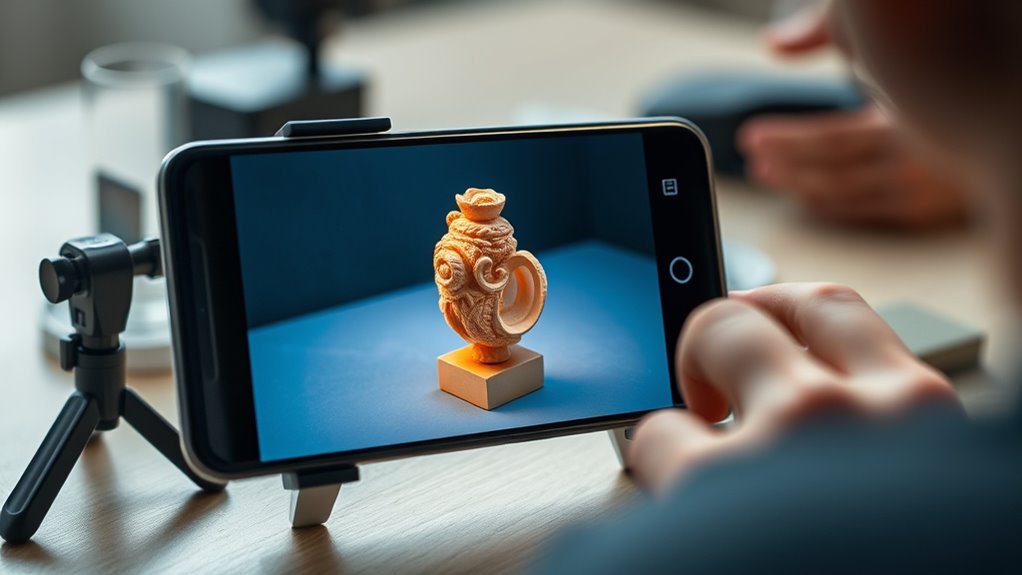
When selecting a 3D scanner for your phone, I focus on compatibility with my device and how well it fits my scanning needs. It’s crucial to take into account the scanner’s range, accuracy, and how easy it is to use in different environments. These factors guarantee I get precise results without hassle, no matter where I scan.
Compatibility With Devices
Choosing the right 3D scanner for your phone starts with ensuring it’s compatible with your device’s operating system and hardware. I always check if the scanner supports iOS, Android, Windows, or macOS, depending on what I use. It’s also important to verify the hardware requirements, like minimum RAM, processor speed, and connectivity options such as WiFi 6 or USB. Some scanners need specific features like OTG support or recent processor generations to work properly. I also make sure the app or software is compatible with my OS version to avoid issues with updates or functionality. Finally, I consider whether the scanner offers wireless or USB connection options, matching my preferred workflow. Compatibility is key to a smooth, hassle-free 3D scanning experience.
Scanning Range and Size
The scanning range and size are critical factors to contemplate because they determine whether a 3D scanner can handle your typical projects efficiently. You’ll want to guarantee the maximum scanning range suits the size of objects you plan to capture, whether small parts or large structures like sculptures or vehicles. Check the single-capture area size to see if it can scan entire objects in one go, reducing the need for multiple scans. Some scanners support dual or multiple modes to handle both fine details and larger objects with ease. Additionally, verify the scanner’s ability to capture large objects, often requiring ranges of several meters. Finally, assess the minimum and maximum object size limits to ensure compatibility with your usual scanning projects.
Accuracy and Precision
Accurate and precise measurements are vital for getting high-quality 3D scans with your phone. Higher accuracy, typically between 0.02mm and 0.1mm, captures more detail and guarantees the model reflects real-world dimensions. Precision refers to the scanner’s ability to reproduce measurements consistently, with minimal deviation from true sizes. Achieving sub-0.1mm accuracy is especially important for detailed work like engineering or dental applications. However, environmental factors such as lighting and surface reflectivity can affect accuracy and precision, making proper setup essential. The hardware quality, including sensors and optical components, directly impacts these factors. When choosing a scanner, look for one that offers reliable accuracy and consistency, ensuring your scans are both detailed and dependable in various conditions.
Ease of Use
To guarantee you get the most out of your 3D scanning experience, it’s important to look for a model that’s easy to operate. A user-friendly interface with clear, step-by-step guides and tutorials can make a big difference, especially if you’re new to 3D scanning. Intuitive controls, like simple buttons or touch navigation, help you operate the device without technical expertise. Compatibility with popular mobile operating systems such as iOS and Android, along with straightforward setup instructions, ensures a hassle-free connection. Built-in automatic features like stabilization, auto-focus, and error correction reduce the need for manual adjustments, making the process smoother. Additionally, lightweight and portable designs that require minimal assembly let you start scanning quickly, no matter where you are.
Environmental Adaptability
Choosing a 3D scanner that performs well in various environments can substantially improve your scanning results. It’s vital that the device works reliably under different lighting conditions, including bright sunlight, without sacrificing detail or accuracy. A good scanner should also handle diverse surfaces—like black, metallic, or shiny objects—without needing spray or powders. Advanced optical technology and face mapping algorithms help restore fine features even outdoors or in challenging settings. Stability and tracking are essential, especially when using the scanner handheld in windy, uneven, or outdoor environments. Compatibility with different ambient conditions ensures you can capture high-quality 3D data whether indoors or outside. Overall, environmental adaptability lets you scan confidently in any situation, making your workflow smoother and more efficient.
Software Support
When selecting a 3D scanner for your phone, ensuring the software support is dependable and user-friendly is essential. Make sure the software is compatible with your device’s operating system, like iOS 15+ or Android 10.0+, and that it receives regular updates for stability and new features. A good app should have an intuitive interface, step-by-step tutorials, and robust editing tools to streamline scanning and post-processing. Check if it supports exporting files in common formats such as OBJ, STL, PLY, or ASC, making it easy to use your scans with other 3D modeling or printing programs. Additionally, features like automatic alignment, mesh optimization, and error correction can noticeably improve scan quality and reduce manual editing. Reliable customer support and firmware updates are also essential for long-term software compatibility.
Portability and Design
A portable 3D scanner for phones must be lightweight and easy to handle, especially during long scanning sessions. Ideally, it should weigh under 300 grams to prevent fatigue and allow smooth movement around objects. A compact form factor that fits comfortably in one hand or features an ergonomic grip improves maneuverability and reduces strain. Wireless connectivity, like WiFi 6 or Bluetooth, is essential for convenience, eliminating the hassle of cables and enabling quick data transfer. Foldable or retractable parts further enhance portability, making the device easier to carry and store. Protective carrying cases and slim dimensions also help users transport the scanner safely across different locations. Overall, thoughtful design ensures the scanner is practical for on-the-go use without sacrificing performance.
Power and Connectivity
Power and connectivity options play an essential role in guaranteeing your 3D scanner for phones performs reliably and conveniently. Make sure the scanner supports the connection type compatible with your device, whether WiFi, Bluetooth, or OTG, and matches your phone’s ports and capabilities. Check the maximum data transfer speed to avoid lag during high-resolution scans. Portable power options like power banks are vital for outdoor or field use, so see if the scanner supports these. Confirm compatibility with your phone’s OS, such as iOS 15+ or Android 10+, and ensure your device has sufficient RAM and processing power. Finally, decide whether wireless connectivity or cable-based setup suits your mobility needs best, balancing convenience with stability.
Frequently Asked Questions
How Do 3D Scanners Integrate With Smartphone Operating Systems?
3D scanners integrate with smartphone operating systems through dedicated apps that connect via Bluetooth or Wi-Fi. I simply download the app, pair my scanner, and it seamlessly communicates with my phone’s OS—whether iOS or Android. The app then processes the data, allowing me to capture, edit, and share 3D models directly from my device. It’s a straightforward, user-friendly process that makes 3D scanning accessible on any compatible smartphone.
What Is the Average Battery Life of Phone-Compatible 3D Scanners?
Think of a phone-compatible 3D scanner as a diligent artist, always ready to capture details without draining your device. On average, these scanners last about 2 to 4 hours per charge, depending on usage and model. I’ve found that moderate scanning sessions won’t quickly deplete my phone’s battery, so I can explore and scan without constantly hunting for a charger. It’s all about balancing power with precision.
Are There Specific Apps Required for Enhanced Scanning Capabilities?
Yes, there are specific apps that enhance scanning capabilities. I recommend using dedicated 3D scanning apps like Qlone, 3D Scanner App, or SCANN3D. These apps often offer advanced features like better texture capture, improved accuracy, and easy editing tools. I find that using the right app makes a huge difference in the quality of your scans, so it’s worth exploring options tailored to your device and needs.
How Do Lighting Conditions Affect Scan Accuracy on Phones?
Lighting conditions really impact my phone scans. I find that bright, even lighting helps me capture more accurate details, while shadows or uneven light can cause distortions or missed features. I prefer to scan in well-lit environments or indoors with consistent lighting, avoiding harsh sunlight or dim settings. Good lighting makes the process smoother and guarantees my scans are precise, saving me time and frustration later.
Can 3D Scanners for Phones Print Directly From Captured Models?
Think of your phone’s 3D scanner as a magic wand—yes, it captures detailed models, but it doesn’t cast a spell to print them directly. While some apps can connect to 3D printers, most phones require exporting the model to a separate 3D printing device or service. So, no, your phone won’t print directly from scans, but it makes the process easier and more accessible.
Conclusion
Think of choosing a 3D scanner for your phone like picking the perfect camera lens—it can make all the difference in capturing every detail. With the options on this list, you’re well-equipped to turn your phone into a powerful tool for 3D scanning. Just remember, the right scanner is your magic wand—bringing your ideas to life with clarity and ease. So, go ahead and start creating your 3D masterpieces today!
